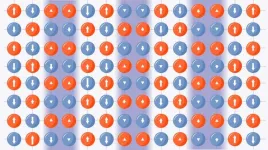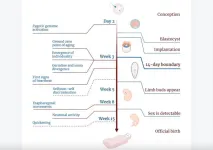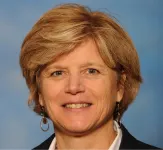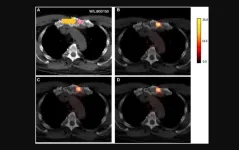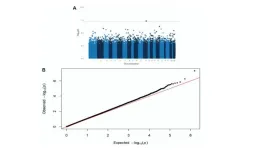(Press-News.org) Superfast levitating trains, long-range lossless power transmission, faster MRI machines — all these fantastical technological advances could be in our grasp if we could just make a material that transmits electricity without resistance — or ‘superconducts’ — at around room temperature.
In a paper published in the May 10 issue of Science, researchers report a breakthrough in our understanding of the origins of superconductivity at relatively high (though still frigid) temperatures. The findings concern a class of superconductors that has puzzled scientists since 1986, called ‘cuprates.’
“There was tremendous excitement when cuprate superconductors were discovered [in 1986], but no understanding of why they remain superconductive at such high temperatures,” says Shiwei Zhang, a senior research scientist at the Flatiron Institute’s Center for Computational Quantum Physics (CCQ). “I think it’s surprising to everybody that almost 40 years later, we still don’t quite understand why they do what they do.”
In the new paper, Zhang and his colleagues successfully re-created features of cuprate superconductivity with a simple model called the two-dimensional Hubbard model, which treats the materials as if they were electrons moving around a quantum chessboard. The breakthrough comes only a few years after the same researchers demonstrated that the simplest version of this model couldn’t perform such a feat. Such straightforward models can spark a deeper understanding of physics, says study co-author Ulrich Schollwöck, a professor at the University of Munich.
“The idea in physics is to keep the model as simple as possible because it’s difficult enough on its own,” Schollwöck says. “So in the beginning we studied the simplest version imaginable.”
In the new study, the researchers added to the 2D Hubbard model the ability for electrons to make diagonal hops, like bishops in chess. With this tweak and thousands of weeks-long simulations on supercomputers, the researchers’ model captured the superconductivity and several other key features of cuprates previously found in experiments. By showing that the humble Hubbard model can describe cuprate superconductivity, the authors prove its worth as a platform for understanding why and how superconductivity emerges.
For most of the last century, physicists thought they understood why some materials superconduct. They thought that superconductivity only existed at extremely low temperatures below about minus 243 degrees Celsius (around 30 degrees above absolute zero). Such low temperatures require expensive cooling systems that use liquid helium.
When cuprates were discovered in 1986, they shocked the science world by superconducting at much higher temperatures. By the mid-1990s, scientists had discovered cuprates that remained superconductive up to around minus 123 degrees Celsius (about 150 degrees above absolute zero). Such temperatures can be reached using relatively cheap liquid nitrogen.
You can imagine a cuprate as a lasagna of copper oxide layers alternating with layers of other ions. (The name “cuprate” comes from the Latin word for copper.) Superconductivity arises when electricity flows with no resistance through the copper oxide layers. The simplest version of the 2D Hubbard model uses only two terms to picture each layer as a chessboard where electrons can hop north, south, east and west.
“When I started working on the Hubbard model in the early days of high-temperature superconductivity, we thought that once we got the pure model simulated on a small ‘chessboard,’ we would totally understand superconductivity,” says study co-author Steven White, a professor at the University of California, Irvine. “But as we developed the techniques, we found that the Hubbard model was much more complicated than we thought.”
Quantum mechanics creates that complexity: The layers are inhabited by electrons, each with either an up or a down spin. The electrons can become entangled. This entanglement means the electrons can’t be treated separately even when far apart, making them incredibly difficult to simulate on a computer.
“Although the Hubbard model can be written down as an equation taking only a line or two of text, because it is applied to hundreds of atoms interacting through the strange laws of quantum mechanics, one could simulate it on a computer as large as the earth for thousands of years and still not be able to get the right answers,” White says.
Shortcuts are needed to deal with that level of complexity — and such shortcuts are the researchers’ specialty. In the ’90s, White and Zhang separately developed now renowned techniques that cut computing time down exponentially. To deal with the enormously complicated model that comes from adding the diagonal hop, the researchers married those two techniques. One technique thinks of the electrons more like particles; the other emphasizes their wavelike structure.
“The big thing about the combination is that the one is strong where the other is weak,” says Schollwöck. “We could make a ‘handshake’ in a certain area where they both work, certifying one method using the other, and then explore the unknown where only one of them works.” Such a collaborative multimethod approach is the legacy of the Simons Collaboration on the Many Electron Problem, which included many CCQ scientists, he says.
Besides the quantum mechanical rules for movement, the number of electrons on the chessboard affects the physics of the model. For many years, physicists have known that when there is the same number of electrons as spaces on the board, the electrons form a stable checkerboard pattern of alternating up-and-down spins. This setup isn’t superconductive — in fact, it isn’t conductive at all. Cuprates therefore require a change in the number of electrons.
In the earlier work by Zhang and his colleagues with the simplest Hubbard model, adding or removing electrons didn’t result in superconductivity. Instead, the stable checkerboard turned into a striped pattern, with stripes consisting of either lines with extra electrons or lines with holes left by the removed electrons.
However, when the researchers added the diagonal hop factor to the Hubbard model, the stripes became only partially filled, and superconductivity emerged. Furthermore, the outcome roughly matched experimental results on cuprate properties.
“Are stripes strictly competing with the superconductivity, or are they causing the superconductivity, or is it something in between?” asks White. “The current answer is something in between, which is more complicated than either of the other answers.”
Zhang says the paper proves the continued salience of the Hubbard model and ‘classical’ computation — that is, developing techniques and algorithms that make better use of regular computers rather than waiting for quantum computers.
“After over 30 years of intense effort by the community without many reliable answers, it’s often been argued that solving the Hubbard model would have to wait for a quantum computer,” Zhang says. “This effort will not only advance research in high-temperature superconductivity, but hopefully also spur more research using ‘classical’ computation to explore the wonders of the quantum world.”
ABOUT THE FLATIRON INSTITUTE
The Flatiron Institute is the research division of the Simons Foundation. The institute's mission is to advance scientific research through computational methods, including data analysis, theory, modeling and simulation. The institute's Center for Computational Quantum Physics aims to develop the concepts, theories, algorithms and codes needed to solve the quantum many-body problem and to use the solutions to predict the behavior of materials and molecules of scientific and technological interest.
END
Quantum breakthrough sheds light on perplexing high-temperature superconductors
Using the Hubbard model, Flatiron Institute senior research scientist Shiwei Zhang and his colleagues have computationally re-created key features of the superconductivity in materials called cuprates that have puzzled scientists for decades
2024-05-09
ELSE PRESS RELEASES FROM THIS DATE:
Vilcek Foundation appoints Dr. Jedd Wolchok to Board of Directors
2024-05-09
The Vilcek Foundation has announced the appointment of Dr. Jedd Wolchok to the board of directors, effective May 1, 2024. Wolchok is the Meyer Director of the Sandra and Edward Meyer Cancer Center and a professor of medicine at Weill Cornell Medicine in New York.
“Jan, Marica, and I are delighted to welcome Jedd to the Vilcek Foundation board,” says Vilcek Foundation President Rick Kinsel. “We look to our board of directors for insight and perspective on our projects and programs: Jedd is not only a leader in immunotherapy and oncology, but an academic and scientific mentor, and a philanthropist in his own right. We are honored and grateful to have him ...
Local health equity and social impact entrepreneurs invited to apply for grants, training
2024-05-09
DALLAS, May 09, 2024 — A recent study revealed that, in the United States, local Black and Latino entrepreneurs receive just 2.6% of all venture capital investment.[1] To help bridge that gap and while addressing health inequities in these local communities, the American Heart Association, celebrating 100 years of lifesaving service, is offering financial grants and expert business consulting to local social health impact entrepreneurs who are focused on achieving health equity. As the Association commemorates one hundred years of lifesaving service as the world’s leading nonprofit ...
The beginning of becoming a human
2024-05-09
“Debates on when human life begins are rooted deep in philosophical history. However, until recently they have been limited by the state of technology.”
BUFFALO, NY- May 9, 2024 – A new review paper was published in advance by Aging (listed by MEDLINE/PubMed as "Aging (Albany NY)" and "Aging-US" by Web of Science), entitled, “The beginning of becoming a human.”
According to birth certificates, the life of a child begins once their body comes out of the mother’s womb. In this new review, researchers Polina A. Loseva and Vadim N. Gladyshev from Harvard Medical School pose ...
Veterinary educator receives national award
2024-05-09
The American Association of Veterinary Medical Colleges has named India Lane the winner of the 2024 Billy E. Hooper Award for Distinguished Service. Lane, associate dean for academic and student affairs at the University of Tennessee College of Veterinary Medicine (UTCVM), has helped transform academic veterinary medical education not only at the college but throughout the profession. The national award recognizes an individual whose leadership and vision have made a significant contribution to academic veterinary medicine.
Throughout ...
Deep learning-based whole-body PSMA PET/CT attenuation correction utilizing Pix-2-Pix GAN
2024-05-09
“We have developed a Pix-2-Pix GAN model to perform attenuation correction on whole-body PSMA [prostate-specific membrane antigen] PET images with 18F-DCFPyL.”
BUFFALO, NY- May 9, 2024 – A new research paper was published in Oncotarget's Volume 15 on May 7, 2024, entitled, “Deep learning-based whole-body PSMA PET/CT attenuation correction utilizing Pix-2-Pix GAN.”
The sequential PET/CT studies oncology patients can undergo during their treatment follow-up course is limited ...
Association between neighborhood deprivation and DNA methylation in an autopsy cohort
2024-05-09
“[...] our study identified one CpG site (cg26514961, PLXNC1 gene) that was significantly associated with neighborhood deprivation in brain tissue.”
BUFFALO, NY- May 9, 2024 – A new research paper was published in Aging (listed by MEDLINE/PubMed as "Aging (Albany NY)" and "Aging-US" by Web of Science) Volume 16, Issue 8, entitled, “The association between neighborhood deprivation and DNA methylation in an autopsy cohort.”
Previous research has found that living in a disadvantaged neighborhood is associated with poor health outcomes. Living in disadvantaged neighborhoods may alter inflammation and immune response in the ...
A better way to control shape-shifting soft robots
2024-05-09
Imagine a slime-like robot that can seamlessly change its shape to squeeze through narrow spaces, which could be deployed inside the human body to remove an unwanted item.
While such a robot does not yet exist outside a laboratory, researchers are working to develop reconfigurable soft robots for applications in health care, wearable devices, and industrial systems.
But how can one control a squishy robot that doesn’t have joints, limbs, or fingers that can be manipulated, and instead can drastically alter its entire shape at will? MIT researchers are working to answer that question.
They developed a control algorithm that can autonomously learn ...
Ensuring data security in biotechnology: strategies and challenges
2024-05-09
The rapid adoption of AI and big data technologies in the biotechnology sector presents unique data privacy and security challenges. To meet these challenges, BGI Genomics actively maintains certifications like ISO/IEC 27001 and BS 10012 while complying with rigorous regulatory standards, including GDPR.
ISO/IEC 27001 is a comprehensive framework that dictates the requirements for an information security management system (ISMS), essential for protecting a company's financial data, intellectual property, and personal details entrusted by third parties. Meanwhile, BS 10012 specifically addresses the management of personal data, aligning ...
An entirely new COVID-related syndrome
2024-05-09
Pradipta Ghosh, M.D., sat down in her office at the University of California San Diego School of Medicine and considered a request from the other side of the world.
Ghosh, a professor in the Departments of Medicine and Cellular and Molecular Medicine at UC San Diego School of Medicine, received an email from Dennis McGonagle, Ph.D., professor of investigative rheumatology at the University of Leeds in the United Kingdom. It began an international collaboration, one that uncovered a previously overlooked ...
Improved wildfire smoke model identifies areas for public health intervention
2024-05-09
UNIVERSITY PARK, Pa. — The Canadian wildfires of June 2023 exposed a large portion of the Northeastern United States to unprecedented levels of smoke. A new model that combines wildfire smoke forecasts and data from ground-based sensors may help public health officials plan targeted interventions in areas most at risk for the negative health effects of unexpected smoke events and air pollution, according to a team led by Penn State scientists.
The researchers reported their findings in the journal Science of the Total Environment.
“Statistical analyses suggest that situations like last year’s ...
LAST 30 PRESS RELEASES:
The Ceramic Society of Japan’s Oxoate Ceramics Research Association launches new international book project
Heart-brain connection: international study reveals the role of the vagus nerve in keeping the heart young
Researchers identify Rb1 as a predictive biomarker for a new therapeutic strategy in some breast cancers
Survey reveals ethical gaps slowing AI adoption in pediatric surgery
Stimulant ADHD medications work differently than thought
AI overestimates how smart people are, according to HSE economists
HSE researchers create genome-wide map of quadruplexes
Scientists boost cell "powerhouses" to burn more calories
Automatic label checking: The missing step in making reliable medical AI
Low daily alcohol intake linked to 50% heightened mouth cancer risk in India
American Meteorological Society announces Rick Spinrad as 2026 President-Elect
Biomass-based carbon capture spotlighted in newly released global climate webinar recording
Illuminating invisible nano pollutants: advanced bioimaging tracks the full journey of emerging nanoscale contaminants in living systems
How does age affect recovery from spinal cord injury?
Novel AI tool offers prognosis for patients with head and neck cancer
Fathers’ microplastic exposure tied to their children’s metabolic problems
Research validates laboratory model for studying high-grade serous ovarian cancer
SIR 2026 delivers transformative breakthroughs in minimally invasive medicine to improve patient care
Stem Cell Reports most downloaded papers of 2025 highlight the breadth and impact of stem cell research
Oxford-led study estimates NHS spends around 3% of its primary and secondary care budget on the health impacts of heat and cold in England
A researcher’s long quest leads to a smart composite breakthrough
Urban wild bees act as “microbial sensors” of city health.
New study finds where you live affects recovery after a hip fracture
Forecasting the impact of fully automated vehicle adoption on US road traffic injuries
Alcohol-related hospitalizations from 2016 to 2022
Semaglutide and hospitalizations in patients with obesity and established cardiovascular disease
Researchers ‘listen in’ to embryo-mother interactions during implantation using a culture system replicating the womb lining
How changing your diet could help save the world
How to make AI truly scalable and reliable for real-time traffic assignment?
Beyond fragmented markets: A new framework for efficient and stable ride-pooling
[Press-News.org] Quantum breakthrough sheds light on perplexing high-temperature superconductorsUsing the Hubbard model, Flatiron Institute senior research scientist Shiwei Zhang and his colleagues have computationally re-created key features of the superconductivity in materials called cuprates that have puzzled scientists for decades
